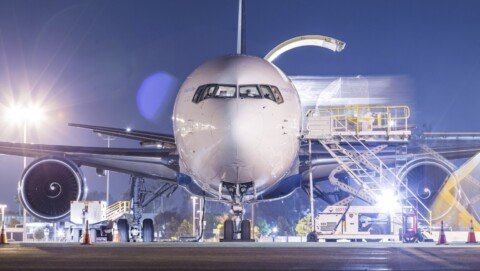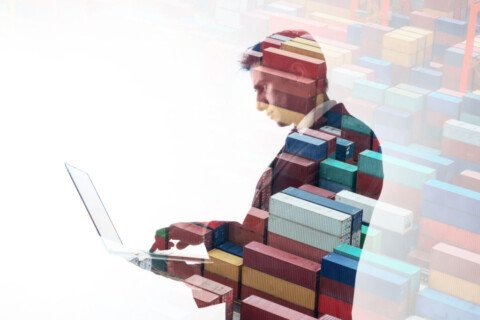The global shipping industry is sailing through turbulent waters since the last few years. Reduced demand for containers, increased turnaround times at ports, unprecedented fall in crude oil prices, high costs, cargo rollover and blank sailings are perturbing sea traders globally. Amidst the pandemic’s deterring effects, the sector is trying its best to adjust to the new normal by standardising business processes and rolling out innovative technological solutions to stay ahead and support the ecosystem. The shipping and ports sector has realised the need to be ‘United’ in these trying times, as they also feel the threat of a new cold war between China and the US which is touted to be much more devastating for globalisation than the pandemic. Amongst all these, accelerated opportunities towards environment-friendly operations, technological integration and increased investments seem to be the only way possible for this sunshine sector to survive and hope for better days ahead.
Ritika Arora Bhola
The global maritime trade lost momentum in the year 2018-2019—escalating tariff tensions between the US and China, global economic downturn, mounting concerns over the trade policy and political crosscurrents, constant dip in the maritime trade growth, weakening multilateral trading system, growing protectionism led to heightened uncertainty and perpetual disruptions in the maritime supply chain.
But, this wasn’t enough.
The emergence of the COVID-19 pandemic also hit the industry hard and literally sent shockwaves throughout global maritime transport resulting in contraction of production and consumption, decline in shipping demand, instability of shipping services, reduced port traffic and turnover. Combating all the challenges, Ocean Freight is still sailing through the turbulent waters. According to the UNCTAD’s Review of Maritime Transport 2019, international maritime trade is expected to expand at an average annual growth rate of 3.4 per cent over the year 2019 to 2024—driven in particular by growth in containerised, dry bulk and gas cargoes along with digital transformation and innovation in maritime operations. However, experts believe, uncertainty remains an overriding theme in the current maritime transport environment, with risks tilted towards the downside.
Sankar Narayanan, Manager, Shipping Services, GAC Shipping (India) says the Maritime logistics sector has been facing disruptions in delivery, congestion and irregularities in container movements since the onset of the first wave of the COVID-19 pandemic.
“Sea-borne cargo movements have been disrupted for more than a year now. Restrictions at different ports have resulted in temporary trade imbalances. Inventories were blocked and shipping lines were often forced to cancel their schedules in full or skip certain port calls at the last minute, resulting in various capacity constraints. This has caused freight rates to rise to unprecedented levels. Although normalcy has resumed, it may take some time before inventory and freight rates stabilise and reach pre-pandemic levels again,” adds Narayanan.
Expressing a strong hope for the Indian market seeing the avenues opening up despite the second wave of COVID-19, Vikash Agarwal, Managing Director, AP – Moller Maersk South Asia says, “We continue to see an unprecedented demand till date. We highlighted seeing an upward trend in demand in the second half of 2020 itself. The developed economies of North America and Europe continue to have an appetite for Indian goods across home improvement, retail, electronics, apparel and lifestyle, as well as the food industry. The exports demand has constantly been on the rise whereas the imports into India have remained subdued. With the current state of global supply chains, we see the demand plateauing only post the year-end, until then we expect status quo.”
The shipping industry is undoubtedly one of the worst-hit industries worldwide. According to rating agency ICRA, due to the impact of the pandemic and the nationwide lockdown enforced to check the spread of the contagion during April-May in 2020, overall cargo throughput contracted by 22 per cent at Major ports. Steep decline was noticed in cargo segments like petroleum products and liquid cargo, thermal coal and containers. Non-major ports also experienced volumes dipping by 22-24 per cent in this period.
Sandeep Nair, Head of Ocean Freight- South Asia, DHL Global Forwarding agrees.“With the reopening of most establishments across India, coupled with steady demand, DHL is already witnessing ocean freight volumes for India reaching pre-pandemic levels.”
“Demand has significantly outpaced capacity and we expect the situation to continue at least until mid-2022. With several countries in Asia being affected by current pandemic measures, we are seeing a shift of volumes to India, whether these shifts are temporary or long-term, only time will tell. However, one thing is for sure; customers are looking to spread their sourcing to different markets,” says Nair.
“Container traffic had already started posting positive growth numbers by September’20. Since then, traffic at Major ports has been consistently showing strong positive growth,”states Dr Abhijit Singh, Executive Director at Indian Ports Association (IPA). “Although shipping and port activities are mature industries and ongoing technological innovations and long-term growth prospects can help address many of the challenges in trade recovery, it also depends on various other factors including rising protectionism, tariff wars, reconfiguration of supply chains, pace of vaccine rollout, etc.”
What we have seen in this crisis, of course, is both the bad of globalisation and the good of innovation.
And this is something Tim Tudor, CEO of ECU Worldwide also feels. Tudor says that the pandemic has created some significant hurdles for the ocean freight industry, but it has also opened new avenues for logistics companies to build resilience and move towards a digital and sustainable supply chain ecosystem.
“Considering the disruptions, small and medium businesses enterprises (SMBs) and beneficial cargo owners (BCOs) continue to seek flexibility, agility and cost savings depending on their logistics partners to deliver a ‘continual feed’ supply chain system with higher frequency departures. In this context, LCL consolidation remains a poignant solution for SMB players as it seamlessly aggregates small shipments and ships weekly, rather than wait for full-cargo-load to ship—which could take a couple of weeks or more, up until the volume justifies. Triggered by space constraints and escalating rates, the ECU Worldwide LCL segment has seen immense growth and is often the high margin segment in the ocean freight space,” tells Tudor.
Tudor further points out that with the surge in e-commerce trade and imports levels hitting astronomical levels the logistics infrastructure is stressed at the moment. However, he feels, congestion will eventually subside as the backlog clears and the demand for consumer goods decreases.
“The broad expectation is that ports and ocean carriers will be able to catch up on the backlog in early 2022, with a return to some semblance of normalcy by next spring,” hopes Tudor.
Riding out through the waves
Despite the setbacks, a milestone has been achieved by the maritime industry, with the growth graphs going upward in 2021 and the industry embracing digitalisation wholeheartedly.
ICRA says, the effects of the paradigm shift are already being felt. Some services, such as those in container shipping and shipbuilding, are consolidating, while others are expanding their scope to include landside and logistic operations. In addition, some of the shipping lines are calling for more governmental support for shipbuilding activities or financing for the technology needed to develop zero-emission vessels. While adjusting to the new normal may entail some potential challenges, the report observes, it could also open some opportunities.
Supporting this processes calls for improved planning, adequate response measures, as well as flexible and forward-looking transport policies that anticipate change. Amidst the pandemic, the industry stakeholders have also united and working towards enhancing the performance of others in the ecosystem, by improving their overall performance, leaving behind the competition, and standing in solidarity.
But, there is still a lot to do and the industry is looking forward to be able to push forward a common vision to stay connected and innovative.
“Be it any business or operations, if we are resilient and are ready to accept what is thrown at us and adapt to the situation, we should be fine,” says Agarwal. “COVID-19 pandemic has taught is that we must be resilient in whatever we do.”
“The pandemic is taking a lot longer to settle down than what we anticipated in the first place. The uncertainties continue even today and the way the market responded could not have been predicted by anyone. The sectors which are growing such as retail & lifestyle, home appliances and so on, might have to scale up while others might have to look at diversifying to sail through.”
“I personally think that instead of betting bigger, operations need to focus on what is it that the market demands. Customer centricity must take the centre stage for every decision that is made. If the customer or market demands to go big on operations then be it, but if it demands on improving efficiencies, then just going bigger is not the solution,” shares Agarwal.
Echoing a similar sentiment, Nair says, the logistics and supply chain is an ecosystem, and everyone needs to play their part. “Customers on one hand can plan their supply chains better, be more organised and predictable in their manufacturing cycles, and share accurate forecasts. While carriers can help by managing capacity and equipment in line with the forecasts from their customers and focus on schedule reliability. Freight forwarders should focus on customer solutions, using visibility tools such as myDHLi and exception management.”
For Nair, the key challenge, amidst the pandemic, has been of capacity constraints, leading from the huge surge in demand and he feels there will be no new services being introduced or large upsizing of existing services being done anytime soon which can fill up the demand and supply gap.
ECU Worldwide has seen global supply chains facing several disruptions involving congestion, capacity constraints, irregularities in container movement, interrupted ocean freight operations, and importantly a highly skewed air and shipping freight rates. But, Tudor says, the industry can learn from these experiences by building capacity to handle cargo smartly, by prioritising cargo by segment and creating more storage around the port facilities to avoid congestion.
“It will be important to see further investments in expanding port sizes to accommodate for future and rampant digitisation for single window clearances that could reduce wait times. Finally, it will be important for logistics players to introduce short- and long-term greener supply-chain initiatives to maximise business outcome,” asserts Tudor.
Singh points out that Competition and Co-operation both can go hand in hand.
“Although carriers collaborate to improve their operational efficiency, they compete with each other simultaneously. Similarly, many port operators who previously ran only their local business now extended their business scope to the regional or global scale. In the era of global economy, a port no longer enjoys a natural monopoly, as was the case in the past. To cope with this changing business environment, a certain form of competition and co-operation amongst ports is necessary. Thus, “Co-opetition” is the only way forward through which stakeholders can enhance the overall system efficiencies and at the same time maintain a healthy competition,” shares Singh.
Responsive strategies and plans to move forward
ECU Worldwide (the wholly-owned subsidiary of India-based All Cargo Logistics) is strategically poised to overcome challenges like the recent pandemic backed by its strong global network of 4000 people, exhaustive network across 180 countries, door-to-door services in 52 countries, and ECU360—its digital platform for global trade, offering single-window shipping.
“To be relevant in the new normal and deliver to a global network it became imperative for us to be more responsive and agile to customise our solutions to help our clients navigate through trying times,” tells Tudor.
“We leveraged a sea-air service from China to Europe via Los Angeles, called XLERATE. Less-than-container-load (LCL) shipments booked by forwarders were moved via ocean carrier from six Chinese ports to Los Angeles for devanning and placement onto airplanes bound for Europe. Our XLERATE service offers the fastest port-to-port transit time of 10 days from Shanghai to Los Angeles. It is a CFS-to-CFS express service that leverages the industry-leading ocean services of MATSON Navigation.”
DHL has also been working closely with its customers to come up with solutions that address the current challenges. DHL has undertaken several new initiatives which include the launch of LCL Reefer product catering to the pharmaceutical industry, the re-launch of Sea-Air product, and working closely with partner carriers to address the capacity and equipment challenges.
AP – Moller Maersk has accelerated the induction of around 260,000 new dry containers into its fleet in the second quarter this year. This comes after the 400,000 TEUs added to its fleet between July 2020 to January 2021 and in total, an amount significantly higher than what would be in-fleeted under normal circumstances. Equipment supply and the repositioning of empties remain a top priority and teams are working around the clock to reposition them. The company’s strategy to integrate logistics across the journey of the goods gives an opportunity to diversify solutions within the logistics landscape. The company is also strengthening its position in the market while providing customers with a single-window access to all their logistics needs.
GAC has also been able to provide uninterrupted services to its customers despite the challenges because of its in-depth local market expertise, customs clearance capabilities and established global network.
Amidst the pandemic, Singh says, India’s Major ports handled the largest number of seafarers. Various technological/digital inductions were expedited during COVID-19 pandemic to maintain smooth functioning without human interference such as follows:
- e-office for internal use; e-invoice, e-payment, e-DO and e-BoL at PCS1x
- Utility for Sign-on & sign-off (e-pass module)
- Utility for data verification of seafarers from chartered flights
- Maritime Training: e-learning, virtual classes, online exit exams
- Online ship Registrations and online charter licensing
What’s next on the Agenda?
Despite the downturn, pandemic accelerated opportunities in innovation and digitalisation and left it on the industry stakeholders to use it in the appropriate way. The industry is left with no other option but to adopt technology in order to survive. The pandemic also made the industry move towards 100 per cent CO2 emissions and environment-friendly operations.
At the moment, shipping industry stakeholders—be it customers, shipping lines, terminals, customs and freight forwarders alike have moved towards electronic means of communication, which is paperless and more environment-friendly.
Tudor says, “Our independent and neutral digital platform, ECU 360, is designed to provide digital quoting, booking, invoicing and tracking tools for small forwarders and customs brokers. The platform allows for one window access for booking and tracking shipments, access to historical data and reduced coordination time. There is also real time tracking available on cargo movement. To bolster our digital prowess further, ECU 360 is building out white label solutions for freight forwarders. The staff is also working on renovating the platform further and has been instrumental in building the ‘Freightos Baltic Index’ which is the world’s largest freight index with live, bookable quotes for containers with 80 million daily price points.”
Nair adds, “DHL has been at the forefront of freight forwarding innovation by introducing a range of services including electronic delivery order, digitally signed GST compatible invoices to our customers, online portal for our vendors and business partners to send in their digital invoices, and most recently, our new myDHLi portal, a fully integrated platform for freight forwarding customers which allows them to quote, book, track and calculate carbon emissions. To fight against climate change we are aiming to significantly de-carbonisation, by neutralising emissions through sustainable marine fuel of all our LCL and FCL shipments globally.”
“We are aware that the cost of logistics contributes to about 14-15 per cent of the GDP in India as compared to 8-9 per cent in more developed countries. The inefficiencies in our logistics ecosystem are responsible for this high cost in India. One of the most effective solutions to removing these inefficiencies will be higher adoption of digital solutions,” comments Narayanan.
Together, Maersk and IBM have developed TradeLens—a neutral platform which utilises data from shippers and cargo owners, 3PLs and freight forwarders, intermodal operators, customs and government authorities, ports and terminals, and several ocean carriers.
“Automation is also an extension of what digitalisation and technology can bring to the table. Automation in processes and systems has helped us tremendously in handling customer’s requirements and queries. It has streamlined processes to ensure that customers get rapid resolutions to their requirements,” says Agarwal.
“There is a strong focus on strengthening the digital infrastructure at major ports. This entire ecosystem will be built on open standards with plug-and- play capabilities to allow changes at sub-system levels without affecting other parts and enable a heterogeneous multi-stakeholder environment to collaborate seamlessly,” shares Singh.
Several initiatives have been undertaken in recent times to improve Ease of Doing Business in Indian Maritime sector, Singh notes while listing down various initiatives implemented by the government.
- The Port Community System (PCS) 1X has been operationalised thus enabling vessel related message exchange between ports and customs.
- Enterprise Business System (EBS) is under implementation at six Major ports and will be extended to other ports in the future.
- Indian ports have adopted some digital initiatives such as on-road examination of containers, automated gate processing enablement, online berthing systems, etc.
- Ministry of Ports, Shipping and Waterways (MoPSW) is leading charge to create a unified logistics system – National Logistics Portal (NLP) – integrating all supply chain elements in India across various modes of transport like roads, railways, etc.
- As a part of same, a National Logistics Portal (NLP) Marine has been envisaged to solve many current EXIM challenges. This step is aligned with the global trend of building end-to-end supply chain solutions in shipping.
- NLP Marine will be developed in conjunction with the existing PCS1x platform and will provide API integration facility with various Port Operating Systems, Terminal Operating Systems, and other stakeholders systems.







